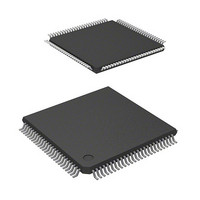HD6417020SVX12I Renesas Electronics America, HD6417020SVX12I Datasheet - Page 180

HD6417020SVX12I
Manufacturer Part Number
HD6417020SVX12I
Description
IC SUPERH MPU ROMLESS 100TQFP
Manufacturer
Renesas Electronics America
Series
SuperH® SH7020r
Datasheet
1.HD6417020SVX12IV.pdf
(511 pages)
Specifications of HD6417020SVX12I
Core Processor
SH-1
Core Size
32-Bit
Speed
12.5MHz
Connectivity
EBI/EMI, SCI
Peripherals
DMA, POR, PWM, WDT
Number Of I /o
32
Program Memory Type
ROMless
Ram Size
1K x 8
Voltage - Supply (vcc/vdd)
3 V ~ 5.5 V
Oscillator Type
Internal
Operating Temperature
-40°C ~ 85°C
Package / Case
100-TQFP, 100-VQFP
Lead Free Status / RoHS Status
Contains lead / RoHS non-compliant
Eeprom Size
-
Program Memory Size
-
Data Converters
-
Available stocks
Company
Part Number
Manufacturer
Quantity
Price
Part Number:
HD6417020SVX12I
Manufacturer:
HITACHI/日立
Quantity:
20 000
Company:
Part Number:
HD6417020SVX12IV
Manufacturer:
RENESAS
Quantity:
63
Company:
Part Number:
HD6417020SVX12IV
Manufacturer:
Renesas Electronics America
Quantity:
10 000
- Current page: 180 of 511
- Download datasheet (2Mb)
2. Countermeasure against a spike on the BACK signal
160 RENESAS
The following describes the countermeasure against a spike on the BACK signal:
a. When BREQ is input to release the bus of the LSI, make sure that conflicts with a refresh
b. The spike on the BACK signal has a narrow pulse width of approximately 2 to 5 ns, which
c. Latching the BACK signal by using a flip-flop or triggering the flip-flop may be successful
operation do not occur. Stop the refresh operation or operate the refresh timer counter
(RTCNT) or the refresh time constant register (RTCOR) of the bus controller (BSC) to
shift the refresh timing.
can be eliminated by using a capacitor as shown in the figure below.
For example, adding a capacitance of 220 pF can raise the minimum voltage of the spike
above 2.0 V.
Note that delay of the BACK signal increases approximately in units of 0.1 ns/pF. (When a
capacitance of 220 pF is added, the delay increases approximately by 22 ns.
or unsuccessful due to the narrow pulse width of the spike. Implement a circuit
configuration which will cause no problems when latching BACK or using BACK as a
trigger signal.
When splitting the BACK signal into two signals and latching each of them using the flip-
flop or triggering the flip-flop, the flip-flop may operate for one signal but may not for
another. To capture the BACK signal using the flip-flop, receive the BACK signal using a
single flip-flop then distribute the signal (see figure below).
Capacitor-incorporating circuit for eliminating a spike
SuperH
Microcomputer
BACK
C
Related parts for HD6417020SVX12I
Image
Part Number
Description
Manufacturer
Datasheet
Request
R

Part Number:
Description:
KIT STARTER FOR M16C/29
Manufacturer:
Renesas Electronics America
Datasheet:

Part Number:
Description:
KIT STARTER FOR R8C/2D
Manufacturer:
Renesas Electronics America
Datasheet:

Part Number:
Description:
R0K33062P STARTER KIT
Manufacturer:
Renesas Electronics America
Datasheet:

Part Number:
Description:
KIT STARTER FOR R8C/23 E8A
Manufacturer:
Renesas Electronics America
Datasheet:

Part Number:
Description:
KIT STARTER FOR R8C/25
Manufacturer:
Renesas Electronics America
Datasheet:

Part Number:
Description:
KIT STARTER H8S2456 SHARPE DSPLY
Manufacturer:
Renesas Electronics America
Datasheet:

Part Number:
Description:
KIT STARTER FOR R8C38C
Manufacturer:
Renesas Electronics America
Datasheet:

Part Number:
Description:
KIT STARTER FOR R8C35C
Manufacturer:
Renesas Electronics America
Datasheet:

Part Number:
Description:
KIT STARTER FOR R8CL3AC+LCD APPS
Manufacturer:
Renesas Electronics America
Datasheet:

Part Number:
Description:
KIT STARTER FOR RX610
Manufacturer:
Renesas Electronics America
Datasheet:

Part Number:
Description:
KIT STARTER FOR R32C/118
Manufacturer:
Renesas Electronics America
Datasheet:

Part Number:
Description:
KIT DEV RSK-R8C/26-29
Manufacturer:
Renesas Electronics America
Datasheet:

Part Number:
Description:
KIT STARTER FOR SH7124
Manufacturer:
Renesas Electronics America
Datasheet:

Part Number:
Description:
KIT STARTER FOR H8SX/1622
Manufacturer:
Renesas Electronics America
Datasheet:

Part Number:
Description:
KIT DEV FOR SH7203
Manufacturer:
Renesas Electronics America
Datasheet:











